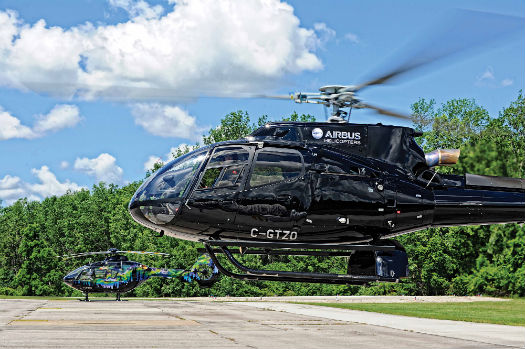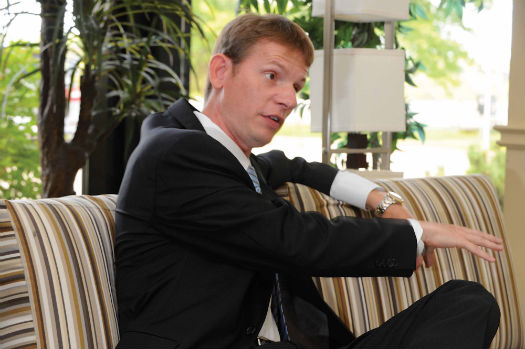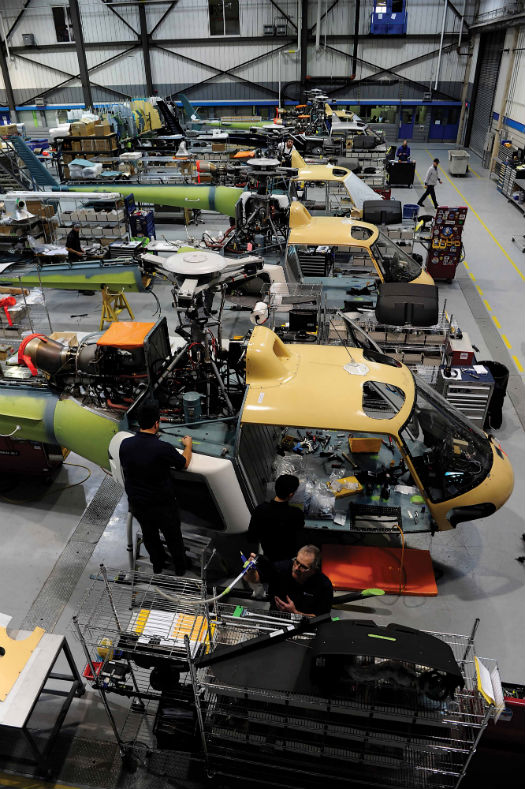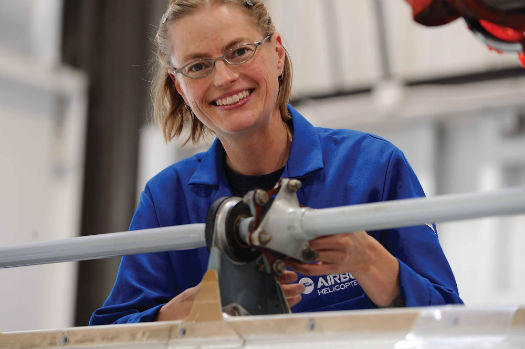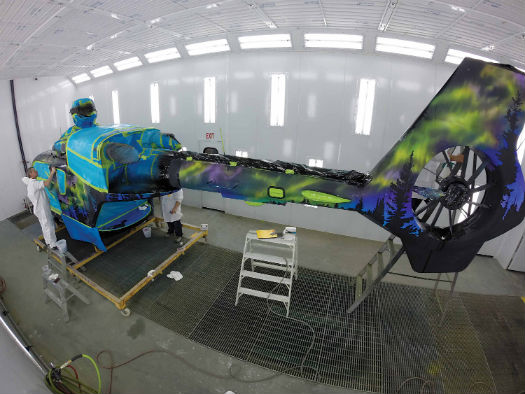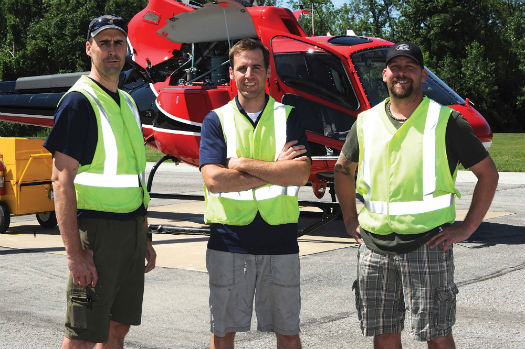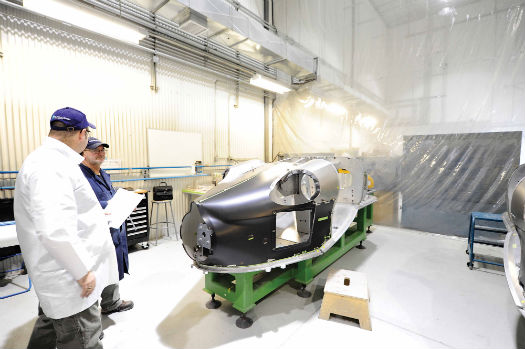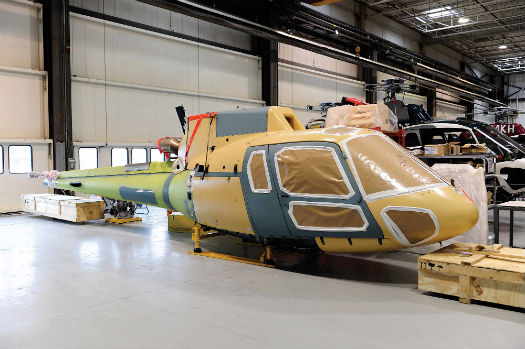Airbus Helicopters Canada (AHCA) is not a standard original equipment manufacturer (OEM) subsidiary. Now celebrating its 30th anniversary, the Fort Erie, Ont.-based company has claimed an impressive 50 percent of all helicopter deliveries in the country since it was established as MBB Helicopter Canada Limited in 1984.
But aircraft sales and completions are just one of five key operational capabilities at AHCA’s 135,000-square-foot facility. It also has a highly experienced engineering department that designs a range of components and modifications; a growing manufacturing component — in which the production of composites is a specialization; offers extensive customer support; and provides maintenance, repair and overhaul (MRO) services.
Since Airbus Helicopters Canada was established as MBB Helicopter Canada
limited in 1984, it has claimed an impressive 50 per cent of deliveries in the country.
Here, an EC130 T2 takes to the air at the company’s facility in Fort Erie, Ont., with
Phoenix Heli-Flight’s new EC135 T2e in the background.
AHCA is one of 21 Airbus Helicopters customer centers, which are strategically located across all five continents.
“What makes Airbus Helicopters Canada unique is the fact that we have one of the broadest ranges of activities of any Airbus Helicopters entity,” said Romain Trapp, president of AHCA, during Skies’ recent visit to the company’s facility.
“Airbus Helicopters Canada has five capabilities — completions, design, manufacturing, support, and maintenance — which makes this company very exciting.”
It certainly appears to be an exciting time for the company, with Trapp’s appointment in July 2013 part of an era of change; AHCA is now an Airbus Helicopters center of excellence for the production of composites, and in February this year won an open contract to begin manufacturing composite engine cowlings for the Airbus Helicopters EC225 and EC725, creating an estimated 40 new jobs.
Romain Trapp, president of Airbus Helicopters Canada, chats with Skies during
our recent visit to Fort Erie. Trapp has been at the head of the company since
July 2013.
Today, AHCA supports over 180 operators in Canada who collectively fly more than 670 helicopters. And, despite the Canadian rotary-wing market currently going through a dip — seemingly part of a historical cycle between growth and contraction — Trapp said AHCA had every reason to look ahead with enthusiasm, especially with the EC225 cowling contract in hand.
“The contract win was key, because it was recognition of what we have been doing over the last 20 years — investing in composites — has been successful,” he said. “Winning this contract has also helped us smooth the slowdown of the helicopter activity in sales and repairs in Canada. The market is very cyclical and very seasonal, so having a manufacturing activity that’s serving the worldwide market helps spread our activity out over the year.”
Ontario Premier Kathleen Wynne (center, gray jacket) joined Trapp and Airbus
Helicopters employees in February 2014 to announce the awarding of a contract to
produce engine cowlings for the EC225/EC275.
Canadian Market a Utility Market
Trapp joined AHCA from American Eurocopter (now Airbus Helicopters, Inc.) where he served as executive vice president and chief financial officer. He said the sheer size of the Canadian market (the second largest civilian helicopter fleet in the world) and the remoteness of the majority of the operations were a couple of aspects that initially surprised him.
“Many of the missions actually are conducted pretty far north in Canada, meaning you are in the middle of nowhere,” he said. “What has made our products so competitive is the fact that we are very reliable. And when you fly in the middle of nowhere, the first thing that you need is the reliability of the aircraft.”
Comparing the Canadian and U.S. markets, he said they were both customer-focused and customer-driven, but differed in the sectors in which the aircraft were operated.
The company receives “green” aircraft from the Airbus Helicopters production lines
in France and Germany, reassembles them, and performs the final completion work
before delivering them to customers.
“The Canadian market is mainly a utility market — 90 percent of the helicopters are flying for utility missions,” he said. “In the U.S., it’s more spread around emergency medical services [EMS], offshore oil-and-gas, law enforcement and corporate. . . . But this creates specific challenges for Canada, because when you have a downturn on the utility market, there is no other market for the operators to offset this downturn.”
With that said, Trapp said the average age of the Canadian helicopter fleet — 29 years old — would provide opportunities through fleet replacement in the coming years, while a growing demand for light twin-engine aircraft, particularly in Western Canada, also offered significant growth potential for the company.
While the country’s deep ties with utility operations tie it to the growth and decline of sectors such as natural resources, they also mean that Canada is seen as a reference point for the worldwide utility market.
“When we develop an option that we want to be successful in the utility market, if it’s not successful in Canada, it’s not going to be successful worldwide,” said Trapp. “We’ve developed a number of utility kits, because we know the needs of our customers, and our parent company fully trusts us [to do so]. They usually tell us, ‘You are in charge.’ ”
Airbus Helicopters Canada has invested heavily over the last five years in new
composite technologies such as this autoclave — an oven for curing composites.
Designing Solutions
AHCA holds over 400 supplemental type certificates (STCs) for various aircraft modifications, most of which are to enhance utility operations. The modifications are designed by the company’s relatively small, but widely experienced, engineering team, which also applies its expertise to a range of other tasks.
“We cover the whole spectrum — we deal with our own STC approvals, we design OEM parts, we customize customers’ aircraft to their specific needs, and support our production and composite manufacturing,” said engineering manager Peter Sharpe. “The variety of challenges that we have here is like nowhere else I’ve worked before.”
Many of the most popular STCs the department creates are for the AS350 AStar, and these include a wire strike protection kit, a vertical reference window, squirrel cheeks and high-visibility doors. Most of these have developed from customer feedback — whether in the form of general suggestions for improvements or more specific item requests.
MRO services are a growing part of the company’s business. On this front, it hopes
to continue maximizing synergies with its sister company in the U.S.,
Airbus Helicopters, Inc.
“The big driver right now is what is being referred to as vertical reference operation, which is anything that will allow the pilot to see the ground, see the load, and see the cockpit,” said Regis Pierquet, director of programs and engineering. “So we need to come up with a solution that gives the pilot the most comfort, the most reactivity, and the most visibility.”
According to Pierquet, the extent of AHCA’s success in creating modifications for the AStar is seen in the fact that some of them have been integrated into the basic platform of EC130 T2 — such as the cargo doors, the enlarged reference window, and the battery location.
He said the department’s size gave it more flexibility to create modifications than a larger organization has. “For us it’s very easy to make prototypes, to make parts with the input from the floor, and reverse engineer them,” he said. “We’re not frozen in a very big structure.”
Pat Garofalo, supervisor of completions design customization, agreed. “In some bigger companies, you do a design, and you never get to see the end product,” he said. “Here we get to follow it through, and I’m on the floor almost every day checking up on my design — making sure it’s working, and that everybody’s happy with it.”
Phoenix Heli-Flight’s new EC135 T2e gets its distinctive Northern lights paint
scheme applied in Airbus Helicopter Canada’s paint shop.
Composite Excellence
In addition to designing and manufacturing a wide variety of modifications, AHCA also manufactures components — chiefly composites – that are sent to Airbus Helicopters final production lines in Marignane, France; Donauwörth, Germany; and Columbus, Miss.
Considered a center of excellence for composite manufacture within Airbus Helicopters, it currently creates a wide range of components including engine cowlings and fairings for the EC130 and AS350 B3; stabilizers, end plates, hub caps and boarding steps for the EC135; and engine cowlings and boarding steps for the EC145/UH-72 Lakota.
While the company has 28 years’ experience of creating composite parts, the past five years have seen it heavily invest in new technology, such as a Virtek laser for ply positioning, new ovens for curing and a computerized cutting table, that have made it a leading edge manufacturer.
Reliability is key for Canadian operators, said Trapp. “What has made our
products so competitive is the fact that we are very reliable,” he said. “And when
you fly in the middle of nowhere, the first thing that you need is the reliability
of the aircraft.”
“We’re really taking advantage of the technology that’s available to make us more competitive in the field,” said Dwyane Charette, director of global supply chain. “We’ve been able to mesh the technology with our past expertize to offer a quality product at a competitive price.”
The award of the contract to produce the EC225/725 engine cowlings, in which it beat 13 bids from external subcontractors, was a demonstration of just how competitive AHCA has now become in the global market.
The 40 jobs created by the contract’s award will add to the 235 employees at the facility, one third of which are working on the manufacture of composites. The current production rate of the Super Puma will see the facility creating over 100 parts a year (each cowling is produced in three parts). The new capability required a restructuring of part of AHCA’s facility, but with all the parts in place, production of the first part began in September, and is on schedule to be delivered in mid-December.
The line is set to reach full production by the second quarter of 2015.
Many employees have spent most of their working lives at the company.
“We all get along, we all work as a team for our product, and we all care
about our product,” said Tammy Brost, a quality assurance auditor who has
been with the company for 26 years.
“It’s a major milestone and it really establishes for us the baseline that says, ‘Yes, we do this; yes, we do it well; and yes, we’re going to grow it,’ ” said Charette. “The group has certainly shown confidence in what we do, and that goes a long way in basically reinforcing that we can make parts for other divisions or externally — it doesn’t even need to be within the group. We’re open for business.”
However, Charette admitted that finding the right skilled labor to enable this growth is probably the biggest challenge — and not just because the company is looking to hire from within the local area.
“Nobody really goes to school for composite manufacturing,” he said. “It’s part of the AME [aircraft maintenance engineer] program, but [the program] doesn’t get into the manufacturing, it’s more the maintenance end. So a lot of what we had here was on-the-job training.”
Because of this, the company has initiated a training program for composite fabrication in alignment with the Canadian Consul of Aviation & Aerospace. When it gains recognition from Transport Canada, Charette said that it would become the first official composite fabricator program in the country.
But it’s not the first training partnership AHCA has in place. Together with the British Columbia Institute of Technology (BCIT) in Richmond, B.C., it offers airframe and engine courses, and similar programs through Ecole Nationale d’Aeronautique in St. Hubert, Que. Earlier this year, it donated an AS350 training aid to BCIT.
“It’s a little point of difference for us — we’re investing in our people, investing in the technology, and investing in the facility to bring all the pieces of the puzzle together,” said Charette.
Quality and safety are together one of the main pillars of the global
Airbus Helicopters organization.
Maintaining the Right Environment
According to director of quality assurance Mike Merritt, quality and safety are together one of the main pillars of the global Airbus Helicopters organization. “We have to make sure that the quality is in the products we’re delivering to the operators so that they have safe operations when they’re operating in remote areas, and then ensure that we have a work culture here of quality and safety across the board,” he said.
The standard of AHCA’s quality management system is reflected in its certification as a registered AS9100 facility, and it also received ISO 14001 certification in early 2013 in recognition of the environmental management system it has in place to reduce company waste and increase efficiencies.
“We’re now in the process of implementing a safety management system [SMS],” said Merritt. “We haven’t been mandated yet by Transport Canada because we’re not an operator, but we’re going ahead and doing it anyway. Most people on the flight line are aware of the philosophy of SMS, but now we’ll actually be able to use it and show the benefits of having that system in place.”
In tandem with that, AHCA is undertaking a lean manufacturing upgrade of its facilities, a process that Trapp said is about 70 per cent complete. “The goal is to improve safety, the quality of our work, and the efficiency of our production processes,” he said. “It has really paid off, because I have been able to see significant improvements in these three areas already.”
The Airbus Helicopters Canada facility in Fort Erie, with the flight line to the left of
the plant. The facility is undergoing a lean manufacturing upgrade to improve
safety, quality and efficiency.
In terms of maintenance, repair and overhaul (MRO) capabilities, AHCA can perform light maintenance to 12-year inspections, including the repair of blades and dynamic components, and conversion between models. Last year the company began offering the repair of the Starflex main rotor head, becoming the only entity outside of Airbus Helicopters in Marignane to offer that service.
Benoit Marcoux, director of repair and overhaul, said one of the biggest challenges for his department is to have a quick turnaround time for dynamic components and blades. “When a customer is down to have a gearbox overhaul, they need a quick solution — they don’t want to wait four or five weeks,” he said. “If you take three weeks it’s too much. So what we did is put together a rental pool to alleviate the problem — to minimize the downtime for the customer. We’ve adapted through the years to our customers’ needs.”
Marcoux said part of this adaption was in maximizing synergies with sister company Airbus Helicopters, Inc. — both in terms of sharing capabilities when needed, but also in working on a more regional basis, providing a convenient OEM maintenance solution to U.S. customers based near the border with Ontario.
The company now produces cowlings for the majority of Airbus Helicopters’
civil helicopter line.
On the West Coast, Trapp said AHCA is working to reinforce the link with Vector Aerospace, an MRO provider based in Richmond, B.C., that was acquired by Airbus Helicopters in 2011.
“The goal there is to better support our customer by using Vector’s capabilities,” he said. “They have very strong capabilities in MRO on the airframe side, in dynamic components and the engine — which is one of the key strengths of Vector.”
Trapp said that AHCA’s overall level of support is improving — through increasing the level of stocks, better forecasting and streamlining the supply chain — but admitted the company still had some progress to make. “It’s not at the level yet where we need to be. We are working very hard to improve the level of support — it is definitely one of the top priorities at our company.”
Depending on what the final completion requires, it can add between 25 to 50
per cent to the value of the helicopter.
In For the Long Run
Today, when a customer takes delivery of an aircraft at Airbus Helicopter Canada’s facility in Fort Erie, all employees are invited to take part in a special ceremony to mark the occasion. Photographs are taken, speeches given, and the workers hear from the customer about the operations the aircraft will be used to perform. It’s one of the changes initiated by Trapp since his arrival at the company, and provides an opportunity for staff to interact with their product’s end user.
“I wanted to strengthen the understanding of every employee working for Airbus Helicopters Canada that whatever their job in the organization, they work for the customer and they are paid by our customers,” said Trapp. “They need to realize in the end that whatever they do — it could be in manufacturing, engineering or finance — all of them play a key role supporting our operators.”
The move has been well received by the company’s employees, many of whom have been with the manufacturer for most of their working lives. Among them is Bill Beam, who works as a supervisor – aircraft completion planner. He has been at AHCA since 1986 when it was MBB — and said the company had just 22 aircraft in the country at time. “It’s just gotten busier and busier and more work has come in as head office is realizing what we can do in Canada here — what we can produce.”
Explaining the appeal of working at AHCA, Tammy Brost, a quality assurance auditor who has been with the company for 26 years, said: “I think it’s the people — we all get along, we all work as a team for our product, and we all care about our product. I’m proud to work here. I’ve been proud ever since the day I started. I love it — I mean we put an aircraft together that’s up in the air flying. How wonderful is that?”
